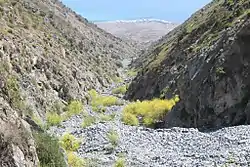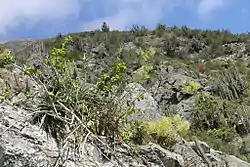Paposo
Paposo or Caleta Paposo is a hamlet is the southern part of Antofagasta Province, Chile. It is located on a narrow coastal plain bordering the Pacific Ocean. The census of 2002 counted 259 inhabitants,[1] who predominantly relied on fishing and mining for a living.[2] Paposo has a desert climate, and "fog oases" exist on mountain slopes a few kilometers inland. In a region almost devoid of vegetation, these oases, also called lomas, support a variety of flora.

Geography and climate
Paposo is located adjacent to a cove on the coast of the Pacific Ocean in the Atacama desert, the driest non-polar desert in the world.[3] Vegetation is nearly absent in most of the Atacama. The foothills of the Andes rise steeply from the sea, reaching an elevation of 700 metres (2,300 ft) less than 2 kilometres (1.2 mi) from the sea.[4]
Paposo and the Atacama have the BWn (desert) climate in the Köppen Classification, characterized by mild temperatures, unusual in desert climates, and much fog rolling in from the nearby ocean.[5] Average temperatures in Paposo range from 13.4 °C (56.1 °F) in July to 20 °C (68 °F) in January, the warmest month.[6] Annual precipitation is 16 millimetres (0.63 in). July is the month with most precipitation with 4 millimetres (0.16 in).[7]
The climatic feature which permits the growth of vegetation on the slopes of the mountains rising above Paposo is the Garua or Camanchaca -- cloud banks caused by the cold waters of the ocean. Inland, on mountain sides up to an elevation of 1,000 metres (3,300 ft), the cloud banks form a dense fog which does not produce rain.[8] The moisture that makes up the clouds measures between 1 and 40 microns across, producing mist and drizzle but too fine to form rain droplets.[9]

References
- Ciudades, pueblos, aldeas y caserios" (2005), Santiago, Chile: Ediciones UNE, p. 141
- "La Flora de Quebrada de Paposo", http://www.chileflora.com/Florachilena/FloraSpanish/SHFloraPaposo.htm, accessed 7 Aug 2017
- "Yungay - the driest place in the world | Wondermondo". www.wondermondo.com. Retrieved 2017-05-06.
- Google Earth
- "World Rainfall Patterns: Cool, Foggy Deserts," pp. 34, 37, accessed 23 Sep 2019
- "Paposo, Antofagasta (Chile), https://www.yr.no/place/Chile/Antofagasta/Paposo/statistics.html, accessed 8 Aug 2017
- "Paposo", https://en.climate-data.org/location/148947/, accessed 8 Aug 2017
- Vesilind, Priit J. (2003). "The Driest Place on Earth". National Geographic. Retrieved 12 September 2013.
- Lavars, Nick (August 25, 2015). "How Chile's fogcatchers are bringing water to the driest desert on Earth". www.gizmag.com. Retrieved 2015-08-25.